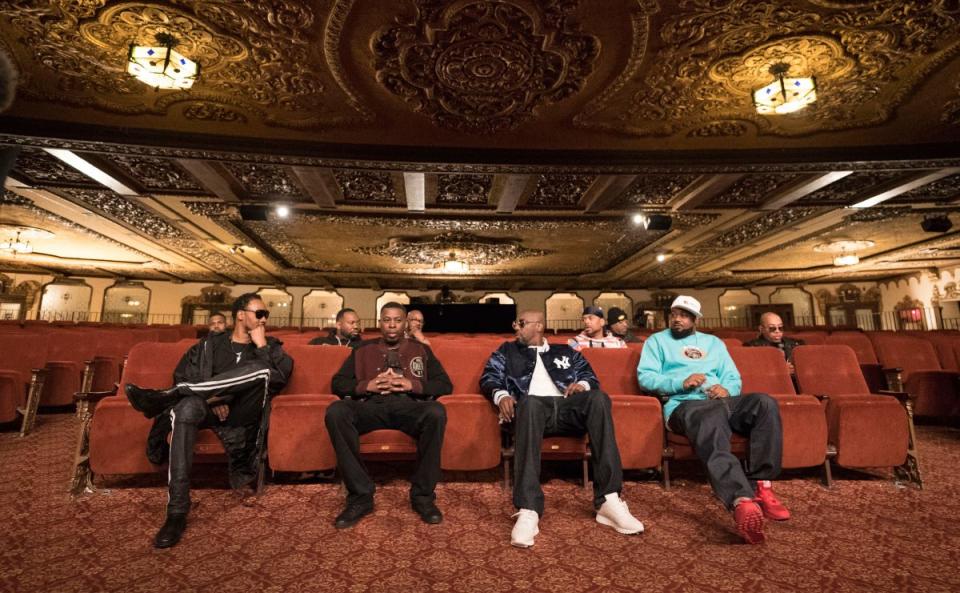Showtime’s Wu-Tang Clan Docuseries Is a Worthy Love Letter to the Iconic Rap Group
Staten Island is the runt of New York City’s boroughs. I know this; I’ve lived there since I was 7. It doesn’t have the history of Brooklyn, the flash of Manhattan, or the cultural richness of the Bronx and Queens. The typical routine of questions from outsiders goes something like this: Do you have to take a boat to get there? Don’t you guys have the world’s biggest dump? Does Vinny from the “Jersey Shore” live there? (For what it’s worth: yes; we used to; and yes—Angelina, too.) So when my 10-year-old self first heard Method Man say, “You know about them fucking Staten kids, they smashing everything” on “Shadowboxin’”—which was released in 1995, the same year I was born—it was a moment of affirmation I had never felt before. That verse soon became the first one I could ever recite word for word.
The Wu-Tang Clan have never forgotten where they came from, and in return the crew is still held close to the heart of Staten Island. Hop on the ferry and take a trip through the borough that the Wu famously nicknamed “Shaolin” and you’re sure to see their iconic logo everywhere: hanging like an American flag, stickers on backpacks and handbags, tattoos on all parts of the body. Walk up to a person of any age or ethnicity and ask them what the acronym “C.R.E.A.M” means and “Cash rules everything around me” will immediately shoot out of their mouths, as if by instinct. Even though Staten Island would prefer to keep the vast Wu legacy to themselves, the group’s impact has of course stretched around the globe throughout the last 25 years. That local and worldwide footprint makes the sprawling Wu-Tang story tough to document, but director Sacha Jenkins pulls it off in his four-part Showtime documentary series, “Wu-Tang Clan: Of Mics and Men.”
Jenkins, who has covered hip-hop in magazines like ego trip and Mass Appeal across the last 30 years, combines intimate new interviews with archived footage—like a mid-’90s video of Raekwon giving a play-by-play while the NYPD harass the residents of Staten’s Park Hill apartments—to capture the essence of the Wu story. That touch of realness is felt from the opening minutes, in which the group’s surviving members—Ol’ Dirty Bastard passed away in 2004—meet at Staten Island’s historic St. George Theatre. (“Wow, I think I probably seen The Wizard of Oz or some shit here,” Raekwon says.) Jenkins then takes us through an enthralling introduction of each member, as they sit in the gilded venue and watch old clips of themselves, “Mystery Science Theater 3000”-style.

WU-TANG CLAN: OF MICS AND MEN
As a standalone episode, the first hour of the series belongs alongside the year’s best television. As early classics like “Wu-Tang Clan Ain’t Nuthin to Fuck With” blare, everyone shares tales about how they connected. Amid the origin stories, Jenkins works reflections about the often-ignored racism and segregation that affects Staten Island into the narrative: At one point, Cappadonna mentions how he had to pass a threatening written message from the Ku Klux Klan on his daily trip to elementary school.
The richness of the Wu’s story is matched by Jenkins’ thoughtful aesthetic choices; the documentary series is never dull to look at. Shots of the Verrazano Bridge and the Staten Island Ferry reinforce the group’s connection to the borough. And though there are moments in the documentary where fans of the Wu will know what comes next, clever editing and the inclusion of news clips and local reports make everything pop like a thriller. Even the series’ talking head interviews are lively thanks to a variety of camera angles.
The second hour shifts to the Wu-Tang Clan’s musical ascent. Archival footage plays a larger role as the story moves on, leading to a chilling moment where Raekwon and Inspectah Deck record “C.R.E.A.M.,” unaware that this song is about to change their lives. It’s balanced with a deep dive into the music industry that includes fascinating interviews with noted rap exec Steve Rifkind, who helped launch the Wu’s career, and DJs Stretch and Bobbito, who used their radio platform to introduce many to the collective. Meanwhile, every member of the group is comfortable in their interviews together and alone, which is saying something given their sometimes-contentious history. But here, they’re all given space to show their distinct personalities, shedding light on how they came together to form such a revolutionary rap crew.
The series’ final two hours suffer from some typical music-documentary framing, as the Wu reach enormous success after their 1997 album Wu-Tang Forever, and deal with inflated egos and inner turmoil. That tension is juxtaposed with a touching section that chronicles the police brutality that affected their borough, focusing on the 1994 murder of Ernest Sayon at the hands of the NYPD—an incident that would be echoed 20 years later with the death of Staten Island’s Eric Garner. The life and death of ODB is told in the third episode, though it proves to be too overwhelming to handle in such a short amount of time.
During the last episode, Jenkins tacks on plotlines that feel minor compared to the stories of the previous three hours—the $2 million album sale to Martin Shkreli, and a slightly bitter interview from RZA’s older brother. But it’s all worth it for a scene near the end that gathers the Wu at a dinner table to drink wine and eat pasta, like a Ghostface Killah verse come to life. This is when Jenkins’ filmmaking thrives, as he shows the undying bond that transformed this 10-man crew from NYC’s most disrespected borough into hip-hop icons the world over.
Originally Appeared on Pitchfork

